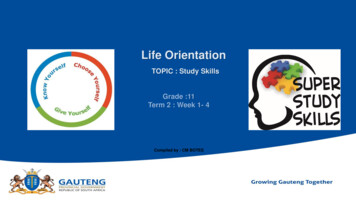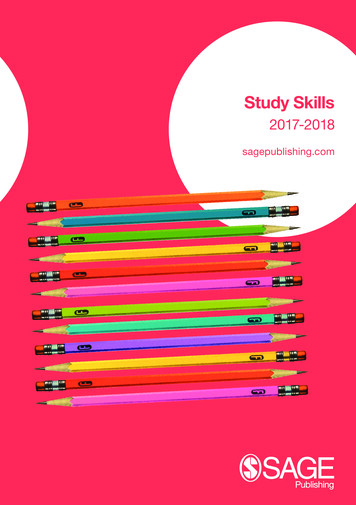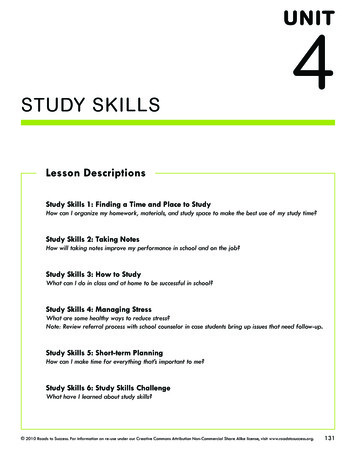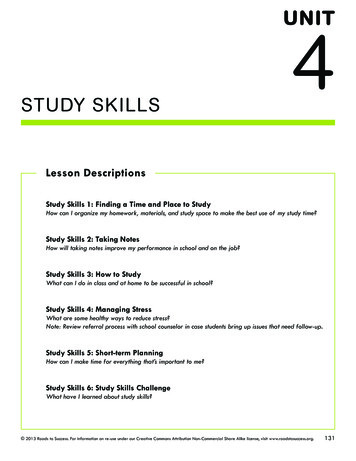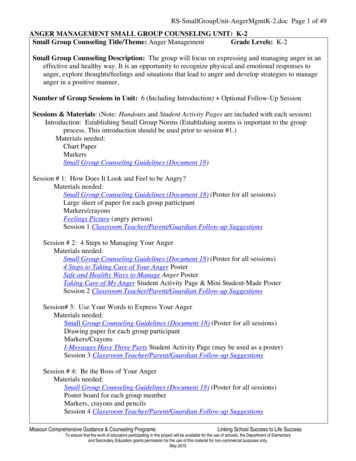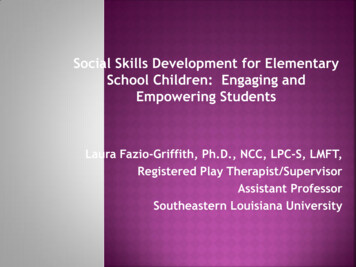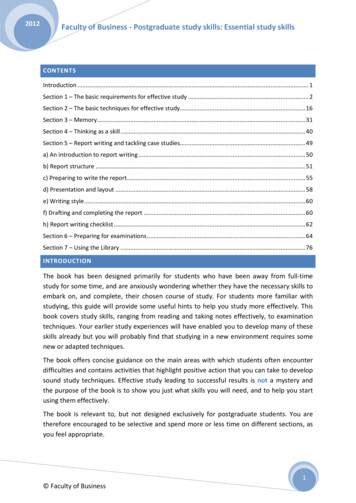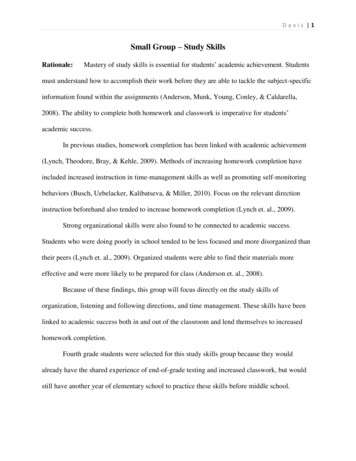
Transcription
Davis 1Small Group – Study SkillsRationale:Mastery of study skills is essential for students’ academic achievement. Studentsmust understand how to accomplish their work before they are able to tackle the subject-specificinformation found within the assignments (Anderson, Munk, Young, Conley, & Caldarella,2008). The ability to complete both homework and classwork is imperative for students’academic success.In previous studies, homework completion has been linked with academic achievement(Lynch, Theodore, Bray, & Kehle, 2009). Methods of increasing homework completion haveincluded increased instruction in time-management skills as well as promoting self-monitoringbehaviors (Busch, Uebelacker, Kalibatseva, & Miller, 2010). Focus on the relevant directioninstruction beforehand also tended to increase homework completion (Lynch et. al., 2009).Strong organizational skills were also found to be connected to academic success.Students who were doing poorly in school tended to be less focused and more disorganized thantheir peers (Lynch et. al., 2009). Organized students were able to find their materials moreeffective and were more likely to be prepared for class (Anderson et. al., 2008).Because of these findings, this group will focus directly on the study skills oforganization, listening and following directions, and time management. These skills have beenlinked to academic success both in and out of the classroom and lend themselves to increasedhomework completion.Fourth grade students were selected for this study skills group because they wouldalready have the shared experience of end-of-grade testing and increased classwork, but wouldstill have another year of elementary school to practice these skills before middle school.
Davis 2Advertising/screening/selection procedures:An email was sent out to all fourth gradeteachers, asking for suggestions for students they believed needed additional study skills andhelp with homework. Three out of four of the teachers responded directly to the email while thefourth teacher was consulted in person. All twelve of the recommended students were givenpermission forms and those who returned signed forms from their parents were invited to join thegroup.Group composition strategies and size:The group contained six students. An equal numberof boys and girls were recommended for this group, and there ended up being two boys and fourgirls in the group after the selection process. The students came from multiple differentclassrooms, ensuring that they would have different experiences upon which they could draw fordiscussions.Overall objectives:ASCA: Academic Domain A:A2 – Acquire skills for improving learning A:A3 – Achieve school success A:B1 – Improve learning A:B2 – Plan to achieve goalsNCSCOS: Guidance Competency Goal 1: The learner will acquire the attitudes, knowledgeand skills that contribute to effective learning in school and across the life span. Guidance Competency Goal 2: The learner will complete school with theacademic preparation essential to choose from a wide variety of substantialpostsecondary options Language Arts Competency Goal 2: The learner will apply strategies and skills tocomprehend text that is read, heard, and viewed. Language Arts Competency Goal 5: The learner will apply grammar and languageconventions to communicate effectively.
Davis 3Overall outcome goals:The overall goal of this group is for students to learn new strategiesfor completing homework and classwork effectively. Students should also be able to make shortterm academic goals they can accomplish independently.Evaluation plan:Discussions are held in group at the end of each session to discuss whichstudy skills the students have learned during that meeting. These discussions incorporate theactivities in which they have participated, as well as times in class they may have utilized thesestrategies. In a small group setting, it is easy to make sure each child is assessed in a round.Additionally, every week, the group chose a goal towards which each student wouldwork. Every day the student would work towards the goal and get his or her teacher’s signature.For each signature students would earn a point. Students would also earn a point for bringingtheir goal sheet to class and for completing other previously chosen tasks. By the end of group,students would need to have reached a group-decided level of points (20) to attend a final groupmeeting with a reward.Theoretical foundation:This group is based on Cognitive-Behavioral theory. Definitive,measureable goals are the central idea of this group. Students also discuss different study skillsand why they work, as opposed to just being given the skills to use and told to use them for noreason. By learning the reason behind the skills while also being able to practice those with oneanother, the students were able to truly apply the skills to their school environments.Multicultural considerations:This group does not include many considerations formulticultural populations since the material is generally applicable to all students. One must keepin mind, however, that when discussing homework strategies, children’s home settings must betaken into account. Some students may not have access to quiet spaces in their homes or to adultswho will help them at home due to their living situations outside of school.
Davis 4Differentiation strategies:The group lessons involve auditory, visual, and kinestheticactivities to help reach a variety of learning styles. There are auditory discussions, visual listsand pictures, and kinesthetic interactive activities for the students to learn about, experience, andpractice various study skills.Rationale for sequence of sessions/activities:The group begins with goal setting anddetermining what members expect to get out of the experience. The next group allows students todetermine whether certain activities are good or bad study skills. They have to be able to identifypositive practices before they can learn how to use those procedures to their advantage. The nexttwo lessons cover study skills such as listening to teachers, following directions, andorganization. The final teaching lesson discusses time management and when the students canmake time for homework and utilizing these strategies in their own lives outside of group. Thelast lesson overall is a reward session for those students who earned points from their goal. Thislesson also allows for a final review and an overall evaluation of the group.
Davis 5Session 1:Lesson objectives:Let’s Be a Group!Students will formulate group rules and expectations. They will also learnabout the goal sheets and the incentive chart that will monitor progress throughout the groupprocess.ASCA: Academic Domain- A:A3.2 - Demonstrate the ability to work independently, as well as the ability to workcooperatively with other students.-A:B1.4 - Seek information and support from faculty, staff, family and peersNCSCOS:-Guidance Competency Goal 1-1.06 – Demonstrate the ability to work independently, as well as the ability towork cooperatively with other students-Language Arts Competency Goal 2-2.02 – Interact with text before, during, and after reading, listening, and viewingLesson outcomes:Students will have set their own rules and expectations for group and willhave started their study skills goal for the week.Lesson assessment strategies:Students will have created a concrete written list of rulesand expectations for group, with each student having contributed at least one rule. This lessonwill also introduce the goal sheets which will be used as a method of assessment for futuresessions.Materials:-Large piece of paper-Markers-“Bob’s Job” story-Goal sheets-Survey “How’s my Homework?”
Davis 6Introduction/Review:Students will be welcomed to group and introduced to the idea oflearning study skills. The large sheet of paper is rolled out and the facilitator/counselor shouldask students for ideas for group rules.Main Content/Experiential Activities:As students begin to name rules for the group, thefacilitator writes them onto the large sheet of paper. Students should discuss their rules with oneanother to make sure everyone agrees with them. Once everyone agrees, each member shouldsign the sheet of paper.After setting group rules, the counselor will read the story “Bob’s Job.” Then studentswill try and guess Bob’s job, which eventually is revealed to be a student.Processing:Students will use the “Bob’s Job” story to discuss what Bob did wrong at schooland what they, as students, are expected to be able to do. This discussion should also cover groupexpectations of which skills they feel they need to practice and work on during group.Closing:The facilitator will go over the goal sheets each student will complete throughoutthe week and explain that each day they have a chance to get a teacher’s signature saying theycompleted their goal (ex. Turn in all homework, clean desk, etc.) and that each signature is apoint towards a special final session. Students will also complete a pre-test/survey, “How’s myHomework?” which will allow the counselor to determine which study skills the students seemto already use as opposed to those they need to learn more about.
Davis 7Session 2:Lesson objectives:What are Good Study Skills anyway?Students will be able to distinguish between behaviors and determinewhether they are positive or negative study skills.ASCA: Academic Domain-A:A2.4 - Apply knowledge and learning styles to positively influence schoolperformance-A:B2.1 - Establish challenging academic goals in elementary schoolNCSCOS:-Guidance Competency Goal 2-2.02 - Distinguish study skills necessary for academic success at each level.Lesson outcomes:Students will be able to label behaviors as either positive or negative studyhabits. They will also be able to list beneficial strategies on their own. Finally, they will have afirst glimpse into goal setting and achievement of short-term goals.Lesson assessment strategies:Students will have brought their goal sheets for the weekand their number of positive daily checks will be recorded through the use of points on theincentive chart. Students will also each have a chance to name positive and/or negative studyskills for the “Good/Bad Study Skills” Chart.Materials:-“Good/Bad Study Skills” Chart-Labeled images of study skills-Markers-Goal sheetsIntroduction/Review:Students will be welcomed back to group and the signatures ontheir goal sheets will be tallied on the incentive chart. The counselor will then introduce thesubject of study skills and ask if they are familiar with any.
Davis 8Main Content/Experiential Activities:Students are shown different pictures that arelabeled as specific behaviors. They will vote on whether they think it is a positive or negativebehavior and then take turns placing them on the correct side of the chart.Processing:Students will discuss together which side of the chart onto which the picturesshould be placed. Afterwards they will each get markers and be able to write their own ideas ofbehaviors, both positive and negative, and explain why they chose the side they did for theirstatements.Closing:Students will be given new goal sheets and the group will decide on what goalthey want to work on for that week. They will also be reminded that they have completed twosessions and that there are four more left before the conclusion of group.
Davis 9Session 3:“Bears-and-Three-Goldilocks-the”: The Importance of OrganizationLesson objectives:This lesson will discuss the importance of organization of both abstractthoughts, specifically in writing, and the organization of physical objects, which can be appliedto desks and notebooks.ASCA: Academic Domain-A:A2.4 - Apply knowledge and learning styles to positively influence schoolperformance-A:A3.2 - Demonstrate the ability to work independently, as well as the ability to workcooperatively with other studentsNCSCOS:-Guidance Competency Goal 1:-1.03 - Practice attitudes and behaviors which lead to successful learning.-1.06 - Demonstrate the ability to work independently, as well as the ability towork cooperatively with other students.-Guidance Competency Goal 2-2.02 - Distinguish study skills necessary for academic success at each level.-Language Arts Competency Goal 5-5.08 - Demonstrate evidence of language cohesion by:-Logical sequence of fiction and nonfiction retells-Time order sequence of events-Sustaining conversations on a topicLesson outcomes:After this lesson, students will be able to come up with multiple methodsof organizing their supplies and be able to apply those methods. They will also understand theimportance of organizing ideas in their writing.Lesson assessment strategies:Students will have brought their goal sheets for the weekand their number of positive daily checks will be recorded through the use of points on theincentive chart.Materials:-“Goldilocks and the Three Bears” story strips-Numbered, colored pieces of paper-Goal sheets
D a v i s 10Introduction/Review:Students will be welcomed back to group, and the goal sheets willagain be evaluated. Students will get a chance to name some of the study skills they identified inthe previous lesson. Then students will be split into dyads for their first activity.Main Content/Experiential Activities:Each pair of students will get a set of strips of paperwith sentences making up the story of “Goldilocks and the Three Bears.” They will have to putthe strips in the correct order to make a sensible story. Afterwards there will be a discussion onwhether the sentences made sense in the original order and how they were able to put the storyback together.The counselor will then take out the different sized, colored pieces of paper. They shouldset them down, number down so that the students only see the colors. Students will be given thechance to put the pieces of paper in specific orders. Afterwards the counselor will turn the piecesof paper over and the students will see another way to put the papers in order.Processing:The discussion after putting “Goldilocks and the Three Bears” in order will allowthe students to tell each other what methods they used to put the story together. They should alsobe able to see the difference in the story before (unorganized ideas) and the story afterwards(organized ideas).The second activity will allow the students to work together and come up with differentmethods of ordering the paper (by color, by size, etc.). They will also put the pieces in numberorder once they see the numbers on the back. They will be able to give each other ideas fororganization and also understand that there are many different ways to organize things.Closing:Students will see that multiple organization techniques are not good or bad, justdifferent; however, they will understand the importance of that organization after the first
D a v i s 11activity. New goal sheets will be distributed and the group goal will be determined. Students willalso evaluate their progress towards the group goal for the reward session.
D a v i s 12Session 4:Lesson objectives:Follow the LeaderThis lesson will focus on the importance of following both written andoral directions.ASCA: Academic Domain-A:A2.4 - Apply knowledge and learning styles to positively influence schoolperformanceNCSCOS:-Guidance Competency Goal 1:- 1.03 - Practice attitudes and behaviors which lead to successful learning.-Guidance Competency Goal 2-2.02 - Distinguish study skills necessary for academic success at each level.-Language Arts Competency Goal 2-2.02 – Interact with text before, during, and after reading, listening, and viewingLesson outcomes:Students will be able to follow oral direction. They will also understandthe importance of reading written directions completely before beginning an assignment.Lesson assessment strategies:Students will have brought their goal sheets for the weekand their number of positive daily checks will be recorded through the use of points on theincentive chart.Materials:-“Following Directions” worksheet-Pens/pencils-“Quiet, Cozy Town” story-Goal sheetsIntroduction/Review:Students will be invited back to group and goal sheets will beassessed for the week. Students will discuss whether they have utilized any of the organizationalstrategies learned in the previous lesson and which they used. Students will then be given the“Following Directions” worksheet.
D a v i s 13Main Content/Experiential Activities:Students will be instructed to fill out the worksheetto the best of their abilities and that they will get an extra point on their incentives sheet for eachquestion they answer correctly. The directions at the beginning of the worksheet instruct thestudents to read all the questions initially; the second to last question tells them to skip allprevious questions, write their name at the bottom of the sheet, and then flip their paper over.The counselor will be able to easily determine which students did and did not read the directionsbeforehand. Discussions will follow.Students will then be assign roles from the interactive story “Quiet, Cozy Town.” At themention of certain words of the story the students will have a specific phrase or noise to make.The counselor will read the story and the students must react to their cue before the story canprogress.Processing:After completing the worksheet, the counselor will go over the questions and theone correct answer. Students will then be asked to discuss the importance of reading directionsand how it saves time and frustration to read them before beginning.Students will also have to work together to get through the story. If one person is notpaying attention, none of the other students get a chance to say their lines. They students tend towork together well to get everyone paying attention to the story. The importance of listening isstressed by the students who are paying attention.Closing:New goal sheets will be distributed and the group goal for the week will bedetermined. Students will assess their progress towards their point goal for the final rewardsession and decide whether they believe the goal is realistic or if it needs to be altered. Studentswill then be reminded that there are two more session left before the end of group.
D a v i s 14Session 5:Lesson objectives:Making Time for SchoolStudents will examine their responsibilities and learn to schedule theirtime to include study time outside of school.ASCA: Academic Domain-A:A2.1 - Apply time-management and task-management skills-A:A2.4 - Apply knowledge and learning styles to positively influence schoolperformanceNCSCOS:-Guidance Competency Goal 1:-1.04 - Demonstrate time management and task management skills.-Guidance Competency Goal 2-2.02 - Distinguish study skills necessary for academic success at each level.Lesson outcomes:Students will be able to use planners and/or calendars to plan their dailyactivities. Students will have a better idea of their responsibilities and their desired activitiesthroughout the day. They will also discuss strategies to rearrange their days to make more timefor homework completion if necessary.Lesson assessment strategies:Students will have brought their goal sheets for the weekand their number of positive daily checks will be recorded through the use of points on theincentive chart.Materials:-Blank list for writing down responsibilities-Blank daily schedules-Goal sheetsIntroduction/Review:Students will review study skills discussed in previous two lessonsafter being welcomed back to group. Then the final set of goal sheets will be examined andpoints will be tallied. The counselor will then hand each student a blank list and ask them towrite down their responsibilities and the things they have to do every day.
D a v i s 15Main Content/Experiential Activities:After writing down their daily duties, the group willgo over what each person had and if they had anything in common. Students often do not listhomework on that list, so the main discussion will concern where to fit homework into their day.Students will also be given a blank schedules sheet so they can write out how much timeeach responsibility takes. More discussion will apply their previous lessons into the dailycalendar.Processing:Students will discuss with one another how much time each one has to focus onhomework and if they have ideas for each other on how to better organize their day to fiteverything in. Students will also have practice in scheduling activities for later use in fifth grade,when many teachers implement homework planning sheets.Closing:Members’ points on the incentive sheet will be evaluated and discussion of thefinal reward will take place. If any students did not reach the goal, the group can decide whetherthose students should be welcomed to the final group, and the students tend to always want towork with their friends to get them to share in the final session.
D a v i s 16Session 6:Lesson objectives:The Grand FinaleThis lesson will include a comprehensive program evaluation and work asa final review of session materials. As the final lesson, termination will be the main focus of thissession.ASCA: Academic Domain-A:A2.4 - Apply knowledge and learning styles to positively influence schoolperformance-A:B1.3 - Apply the study skills necessary for academic success at each level-A:B1.7 - Become a self-directed and independent learnerNCSCOS:-Guidance Competency Goal 2-2.02 - Distinguish study skills necessary for academic success at each level.-2.03 - Choose to be self-directed and independent learners.Lesson outcomes:This lesson will determine the group process’s overall effectiveness inteaching students about various social skills.Lesson assessment strategies:Along with assessing the students’ perception of the groupas a whole, the program evaluation worksheet also asks students to report what they have learnedfrom the group process. Their responses will show what information they have retained anddeemed important enough to report.Materials:-Program evaluation worksheets-Previously discussed rewardIntroduction/Review:Students will be welcomed back to the final group session. Timewill be spent at the beginning reviewing all of the past sessions and which lessons each memberremembers the most. The reward will also be implemented (i.e. popcorn, pencils, etc.).
D a v i s 17Main Content/Experiential Activities:Students will fill out program evaluations whichwill ask them to recall the best and worst parts of group, as well as what they have learned fromthe group experience. This will help determine which lessons are most salient to them after time.Processing:The discussion of previous lessons will act as an evaluation tool to see what theyremember, but it will also act as a final review and give everyone a last chance at exposure to thematerial.Closing:The final part of group should be spent attending to termination of the group andthe feelings that triggers in members. Any resistance should be addressed with immediacy andthe group members should be allowed to discuss with each other how group has affected themand how they can use their new knowledge in the classroom. The counselor will thank all themembers for coming and group is finished.
D a v i s 18Works CitedAnderson, D.H., Munk, J.H., Young, K.R., Conley, L., & Caldarella, P. (2008). Teachingorganizational skills to promote academic achievement in behaviorally challengedstudents. Exceptional Children, 40(4), 6-13.Busch, A.M., Uebelacker, L.A., Kalibatseva, Z., & Miller, I.W. (2010). Measuring homeworkcompletion in behavioral activation. Behavior Modification, 34(4), 310-329.Lynch, A., Theodore, L.A., Bray, M.A., & Kehle, T.J. (2009). A comparison of group-orientedcontingencies and randomized reinforcers to improve homework completion andaccuracy for students with disabilities. School Psychology Review, 38(3), 307-324.Plymale, O. (2003). “All Stars”: Small Group Counseling Sessions. Wilson County Schools.
D a v i s 19Appendix: Resources and Handouts
D a v i s 20
D a v i s 21
D a v i s 22
D a v i s 23
D a v i s 24
D a v i s 25
D a v i s 26
D a v i s 27
D a v i s 28
D a v i s 29
D a v i s 30
whether they are positive or negative study skills. ASCA: Academic Domain -A:A2.4 - Apply knowledge and learning styles to positively influence school performance -A:B2.1 - Establish challenging academic goals in elementary school NCSCOS: -Guidance Competency Goal 2 -2.02 - Distinguish study skills necessary for academic success at each level.
